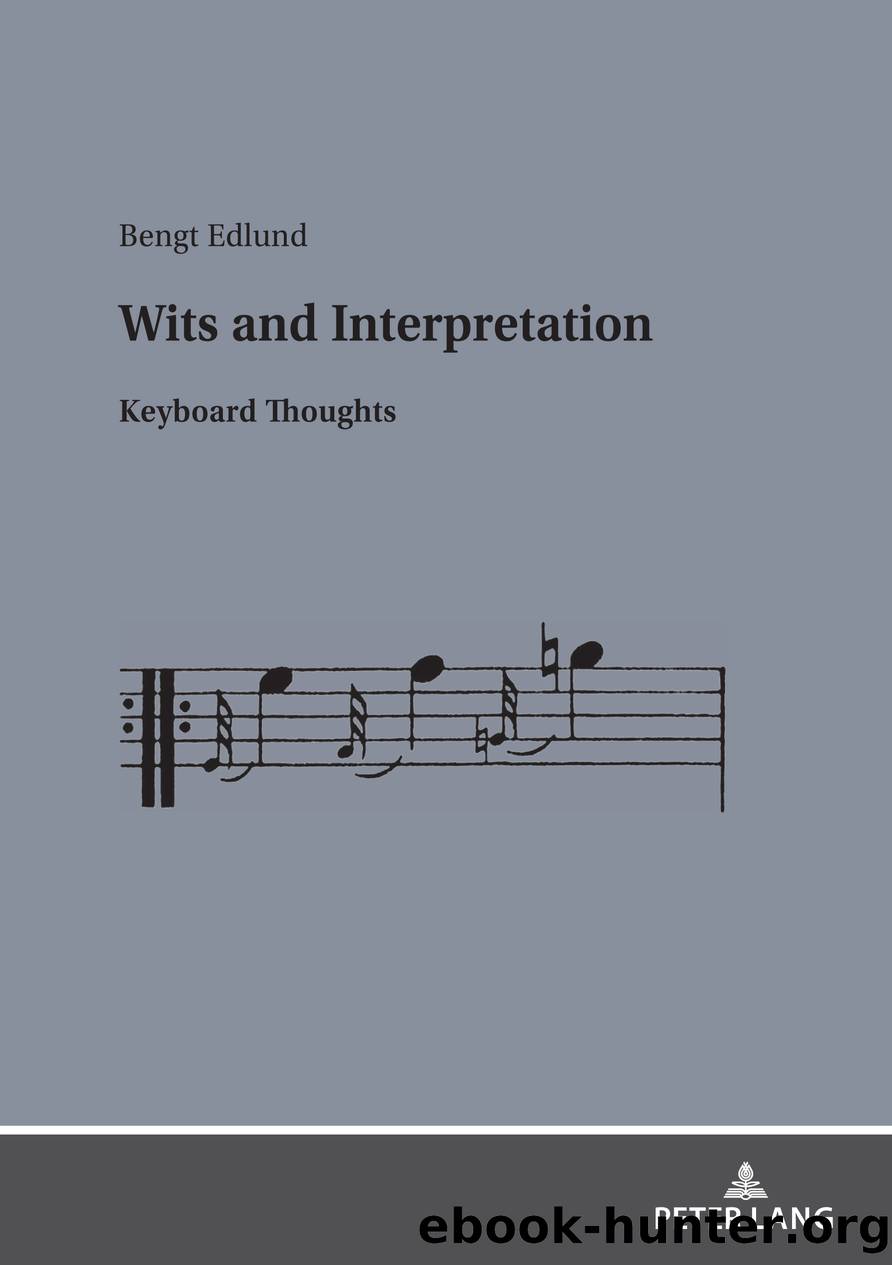Wits and Interpretation: Keyboard Thoughts by Edlund Bengt

Author:Edlund, Bengt
Language: eng
Format: epub
Publisher: Peter Lang
Conclusions
The reading of the minuet just accounted for is not intended to show the workings of an overall cadence lending tonal unity to all middleground voice-leading activities and by extension to all surface motions. No encompassing Ursatz (not even a flawed one) is to be seen in Ex. 5. Instead, and this perhaps belongs to the unique, Mozartian quality of the music, there are no less than five separate âtonalâ progressions, one for each period/section.14 These progressions represent in turn their A-major, E-major, towards-E-major, A-major, and A-major tonalities; tonalities that are finally confirmed not by descending, but rather by ascending upper lines supported by local cadences featuring root-position chords. But the minuet seems to have another unifying agent: the fifth-degree e2, held as a structural drone to be eventually released in the first and fourth/fifth periods, eventually established as the local tonic note in the second period, and left-and-eventually-returned-to in the middle section.
In other words, the minuet makes up a coherent and reasonably unified A-major piece of music. It is a pity that it cost Schenker a mistaken third-degree Urlinie to demonstrate its tonal unity. His reading leaves the pervading presence of the fifth degree out of account; and his imposed fundamental structure destroys the fresh start of the second period, degrades the fifth period that actually brings the tonal conclusion, and gives rise to a most questionable b2âb1 coupling/prolongation expressing the dominant â an idea that obliterates the harmonic expansion of the middle section and obscures the form of the piece. In order to show that the music unfolds âorganicallyâ, i.e. that it can be pressed into one of his standardized Ursatz corsets, it was necessary for Schenker to resort to unlikely readings of various details and to sheer manipulations. Why else did he enforce a misleading and confusing reduction that the music obviously resists, an analysis that leaves the listeners out of account and the musicians without assistance?15
â191 | 192âConsidering the alternative analysis proposed in Ex. 5 from the musicianâs point of view, it appears that the connections it brings to the fore are possible and also rewarding to convey because they have not lost contact with the musical surface. There are âlong linesâ in this minuet â trust Mozart and respect the integrity of his text, and you will find them.
Giving the last word to our pianist, she is still not quite satisfied with the account of the middle section; it is still too Schenkerian for her purposes. It would have been better if Ex. 5 had brought out the appoggiaturas, not their resolutions, in mm. 20â26. She is certainly aware of the rule that âtonal structuresâ are not supposed to be built on dissonances, that consonances are to be retained when construing reductive connections, but she does not care since in music wine counts for more than water.
Understanding the right-hand melody in this way brings out the similarity between m. 19 and m. 23; cf. Ex. 6. The latter bar will now emerge as a transformed,
Download
This site does not store any files on its server. We only index and link to content provided by other sites. Please contact the content providers to delete copyright contents if any and email us, we'll remove relevant links or contents immediately.
Kathy Andrews Collection by Kathy Andrews(10519)
The remains of the day by Kazuo Ishiguro(7551)
Spare by Prince Harry The Duke of Sussex(4195)
Paper Towns by Green John(4169)
The Body: A Guide for Occupants by Bill Bryson(3800)
Be in a Treehouse by Pete Nelson(3212)
Harry Potter and the Goblet Of Fire by J.K. Rowling(3045)
Goodbye Paradise(2962)
Never by Ken Follett(2880)
Into Thin Air by Jon Krakauer(2701)
The Remains of the Day by Kazuo Ishiguro(2618)
The Genius of Japanese Carpentry by Azby Brown(2609)
The Cellar by Natasha Preston(2595)
Drawing Shortcuts: Developing Quick Drawing Skills Using Today's Technology by Leggitt Jim(2532)
120 Days of Sodom by Marquis de Sade(2437)
Architecture 101 by Nicole Bridge(2350)
The Man Who Died Twice by Richard Osman(2298)
Machine Learning at Scale with H2O by Gregory Keys | David Whiting(2290)
Fairy Tale by Stephen King(2069)
